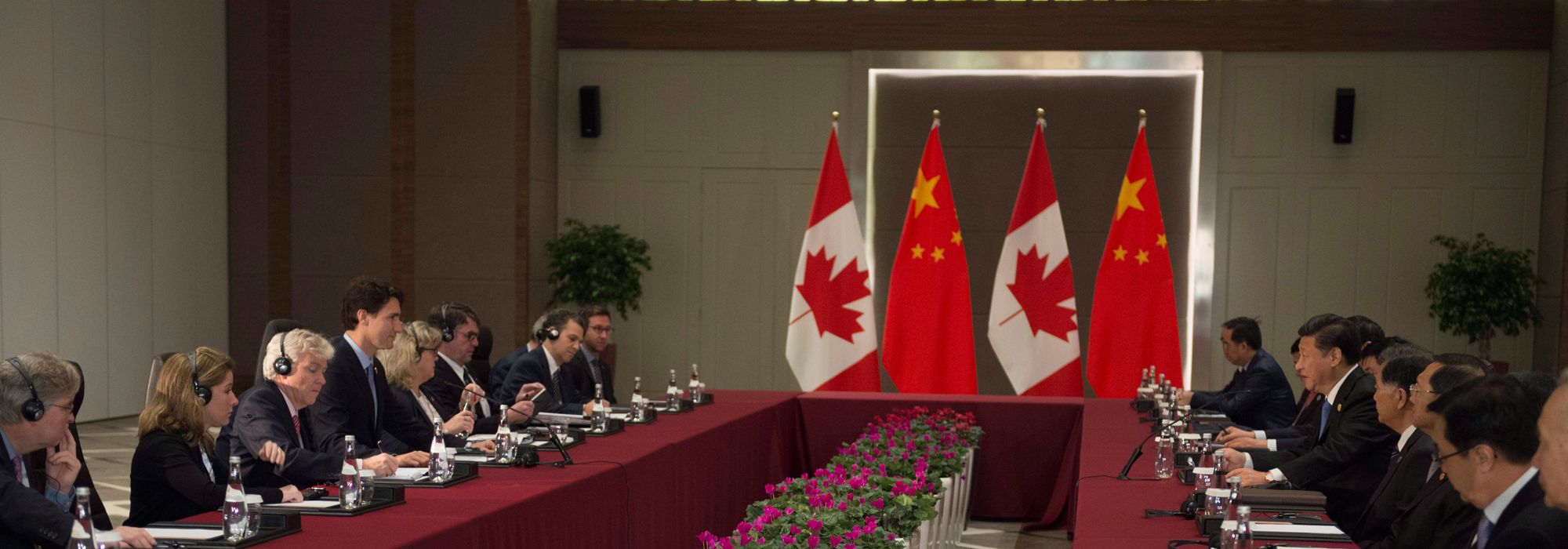
After a decade of intermittent and ambivalent engagement with our second-largest trading partner, it’s time for Canada to plan concretely for the future of its relationship with China. Prime Minister Justin Trudeau’s bilateral visit to China next week and the G20 leaders’ summit on September 4-5 provide opportunities to take a more strategic approach and identify actions that our two countries can take together.
China’s signature theme for the summit is “an innovative, invigorated, interconnected and inclusive world economy,” reflecting its growing economic and geopolitical presence. These are themes that resonate in Canadian economic and foreign policy.
China will increasingly matter for Canadian prosperity and security in unprecedented ways. The world’s largest population, second-largest economy and largest goods exporter is also the largest trading partner of almost every country in Asia. It is home to more than 100 million middle-class families and is changing fast.
But high levels of investment and decades of spectacular export-oriented industrial growth have run their course, leaving behind serious environmental degradation and regional inequality. China’s current economic development strategy, the 13th Five-Year Plan (2016-20), aims to address these issues by rebalancing the economy. Beijing seeks to rely on innovation to drive sustainable long-term growth, and on consumption spending to replace more than 30 years of heavy investment spending and to meet burgeoning middle-class demand.
Economics is only part of the story. China ranks second to the United States in defence spending and has become more assertive of its sovereignty in maritime disputes. It is stepping up its leadership on global issues and providing leadership, as in the G20, within multilateral institutions. At the same time, at home, the political space for civil society and dissent has been reduced.
Canada’s choices for the relationship are complex ones. As tensions rise between China and the United States in the Pacific region, China is central to what will unfold and its movements are difficult to predict. The country’s preoccupations include its myriad domestic challenges, its uncertainty about its future role in the world order and its own form of authoritarian capitalism, which seems unlikely to change in the foreseeable future.
China’s preoccupations imply that we and others must live with China as it evolves rather than expecting it to become more like us. Living with China means learning about it and avoiding misinformation and misperceptions. We should create the foundations of public understanding and address palpable levels of public anxiety reflected in recent public opinion surveys by the Asia Pacific Foundation of Canada (APFC). In 2014, 60 percent of respondents saw China’s growing military power as a threat to the Asia-Pacific region and more than half felt that China’s influence was threatening the Canadian way of life.
Wariness about China is not unique to Canadians, but our response contrasts sharply with that of Australians, who hold more positive and stable views despite sharp differences of opinion about China policy. A 2015 Pew Center poll found 57 percent of Australians held a favourable view of China, close to 20 points higher than the Canadian figure that year and similar to a global median that has been slowly increasing over the past five years.
Public ambivalence in Canada (business and academics are more positive) reflects three issues. One is experiential: the outcomes of fast-multiplying interactions that are not always positive, such as rising house prices in major cities blamed on Chinese investment. Confucius Institutes, funded by the Chinese government and established in foreign universities, have been criticized for infringing on academic freedom.
A second issue is Canadian perceptions of China’s political system, the role of the state in its economy, and societal values and practices that differ greatly from ours. Canadians question China’s record on human rights and democracy and the overall legitimacy of the Chinese state.
Finally, Canadians also worry about China’s rising international presence, its rapid military modernization, its assertive stance on maritime border issues and the potential threat that it poses to the established international order.
The history of Australia’s relationship with China differs and is instructive. Australians have invested a lot in learning about China. In the past 30 years Australia’s leaders have commissioned two white papers on relations with China and have actively engaged in public discussion and encouraged public debate. In Canada such leadership is missing; a fresh narrative is also required that recognizes China as it is, not how we would like to see it become. Economics and security are central threads to how we should see China.
Deepening the Economic Relationship
One of the key economic themes in a fresh narrative should be collaboration around significant complementarities. Put simply, the Chinese seek secure supplies of food, energy and natural resources while Canada seeks a secure demand for its rich endowments. China is increasingly turning to clean energy sources, conservation and renewables while Canadians are becoming innovators in those sectors.
- Energy and environment: Energy and the environment could be a game changer for the relationship. There is significant market development opportunity for Canadian firms — eastern Canadian hydroelectric and nuclear expertise, Saskatchewan uranium production, and oil and natural gas exports from the West and the Atlantic provinces. Meanwhile, managing the environmental impacts of energy production and its use could also shape the future bilateral relationship and could be a signature item in the next phase of Canada-China relations. China has been ranked by the U.S. Energy Information Administration as the world’s largest net importer of petroleum and other liquid fuels.
- Food security: China’s middle-class families are demanding food security after several high-profile tainted-food scandals. With rising family incomes, tastes are changing to more meat-based, high-protein diets. These factors, along with shortages in animal feed, are changing import and investment patterns. Just as China is modernizing agriculture, Canadians are investing heavily in innovative practices and technology to increase productivity. Canadian pork exports to China grew fivefold between 2009 and 2012, and bilateral collaboration on pig genetics is ongoing.
- Infrastructure and transportation: Both industries have high potential for market development over the long term, especially as China strives to improve linkages along the historic land and sea routes between China and Europe (the One Belt, One Road initiative). Canadian firms have globally recognized expertise in land- and marine-based transportation technologies, construction, construction machinery and building materials. The potential for new business is significant in transportation services, including aerospace products. Future collaboration is also possible, linking our own Asia-Pacific Gateway initiatives — but only if we actively participate in these projects and the accompanying value chains.
- Services: Middle-class demand is also creating major opportunities for collaboration in service industries such as tourism, education, insurance and health care. At the same time China’s economic rebalancing to shift sources of growth in incomes and employment to rely more on consumption and services is encouraging rapid growth in private firms, in number and size, providing sometimes intense competition in the home market and abroad. Service industries, traditionally dominated by state-owned enterprises, are being opened to competition from non-state firms.
Developing a Canadian role in Asia-Pacific security
China’s approach to bilateral relations with major countries has shifted dramatically since Xi Jinping became president in 2013. Defence spending and the sophistication and range of its military assets are expanding quickly. Chinese-sponsored security forums such as the Shanghai Cooperation Organisation and the Conference on Interaction and Confidence Building Measures in Asia do not include the United States.
Chinese influence and power do not come close to matching those of the United States, but Beijing is working to place itself at the centre of a more tightly integrated and networked Asia with the new One Belt, One Road infrastructure and trade initiative. The Asian Infrastructure Investment Bank (AIIB) was created specifically to finance international infrastructure projects, beginning with those in Asia. With such initiatives, the question is this: How does the regional order move from one premised on American primacy that can no longer be sustained to a new one that has yet to be shaped? Canada has been a silent spectator over the past decade as geopolitical tensions between China and the United States have intensified.
Canada’s closest partners in the region — the United States, Australia, Japan and South Korea — all pursue policies embracing elements of continued or expanded engagement, while trying to counter and contain China’s diplomatic and military influence. The Obama administration is strengthening defence relations with its allies, expanding US naval capabilities and insisting that American-underpinned international rules prevail.
Canada’s position in the region has not been articulated or seriously debated. Our defence cooperation with Japan, South Korea and Singapore is not grounded in alliances — Canada has been rebuffed in efforts to join the high-level ASEAN Defence Ministers Meeting Plus and the East Asia Summit of political leaders.
For more than a decade Ottawa has not made a major statement or launched a major institutional initiative on security in the region. The silence and diminishing visibility undermine our credibility: Canada is no longer viewed as an engaged and full partner by China or by Asian thought leaders. Instead, we are perceived as distant, aloof and reactive, focused narrowly on our own economic advantage.
Unless we are a multidimensional player, Canada will not be accepted as a participant in regional initiatives to dampen geopolitical rivalry or to set the region’s rules and framework. Even if we choose a reactive approach, it should be articulated so that our partners — and Canadians — know what to expect.
Raising our game
Clearly Canada should raise its game in China and in Asia. Recognizing the inseparability of economic policy and security policy, Canada needs a more comprehensive, bold and long-term policy framework. It should be one that explains our goals to Canadians and our international partners and augments the heavy economic focus with a commitment to participate in managing the new and evolving security equation.
In a recent IRPP essay, University of British Columbia professor Paul Evans and I recommend future conduct of the relationship along the lines summarized here.
- Reboot the political relationship: In Asia, more than in the West, key linkages are built on foundations of state-to-state relationships maintained through regular contacts among prime ministers and presidents. Forty-five years ago, Canada was an early mover in recognizing China’s Communist regime. Today, because the narrow focus on commercial interests has dominated strategic issues, Canada is not taken seriously. Other countries have established high-level bilateral mechanisms, such as the US-China Strategic and Economic Dialogue and the Singapore-China management committee that is headed by very senior officials. Leaders from Australia, Germany and the United Kingdom not only accompany missions to promote trade, resulting in landmark commercial deals; they directly encourage building trust and understanding through deepening ties among cities, citizens and businesses. They engage with China on broader global and geopolitical issues.
- Coordinate at home: Ottawa should play an active role in developing and communicating a fresh narrative and in convening the many stakeholders who travel separately to China. A leadership group could be established, such as a special cabinet committee, or the role could be an initial focus of the House Committee on Global Affairs. A national commission or panel could be created to define the challenges and opportunities of deeper bilateral relations. Its activities could include moderated forums for individual citizens to interact with experts over what is at stake, how to manage irritants and risks, and how to find effective solutions. Here universities have a special role to play, especially in frank discussion of concerns and navigating differences in values, institutions and practices.
- Build on economic complementarities: Collaboration can take many forms. One possibility is equity investments by Canada’s large pension funds in Canadian and Chinese agricultural firms aiming to expand food production and promote innovation; another is to organize mechanisms in Canada to enter into long-term supply contracts as part of cross-border trade in goods and services. Collaboration on energy security depends in large part on Canada addressing transportation bottlenecks. In 2012, the APFC’s Canada-Asia Energy Futures Task Force recommended a public energy transportation corridor, created by governments, regulated like a public utility and operated by the private sector. The proposal is an innovative way to recognize and mediate among the multiple interests concerned with new pipelines in British Columbia. The benefits of collective action in the national interest outweigh individual interests and can be constructed in ways that minimize risks, maximize public gains and fairly share the benefits.
Goals should be set for 5- and 10-year two-way flows of goods and service trade and investment. In trade, doubling the value of exports to China by 2020, to $40 or $50 billion from $21 billion in 2013, could create more than 2 million new jobs. Setting a similar target for Canadian outward investment is problematic because it depends heavily on firms’ strategies. With respect to Chinese investors in Canada, our screening of direct foreign investments needs to be revised to be more transparent and based on best practice. The existing regime is ranked by the OECD as one of the most opaque among its membership.
Other initiatives to build on complementarities include becoming a member of the AIIB, encouraging and assisting China’s entry into a second round of the Trans-Pacific Partnership, and pushing for the APEC-sponsored Free Trade Area of the Asia-Pacific. Negotiating a bilateral free trade agreeement should also be carefully considered.
- Prepare an Asia-Pacific security and defence White Paper: The absence of such a paper means Canadians lack a strategic assessment of regional dynamics and threats, strategic options and a clearer idea of steps toward reengaging with regional institutions and partners. Also essential is analysis of the kinds of assets — military, diplomatic, nongovernmental — that Canada needs in order to play a constructive role in building peace and stability at a time of a shifting balance of power and a resurgent China.
Ultimately, we should prepare for a much larger Chinese presence globally and in Canada no matter what measures we do or do not take. The reality is that we should learn about China and live with it as it evolves, rather than expecting or requiring major changes in its basic institutions. At the same time, we should advance concepts like the rule of law and good governance and protect Canadian values and institutions at home.
Prime Minister Trudeau’s message to Canadians around his visit could articulate such a narrative. To help further in addressing public ambivalence, he could also articulate the two countries’ shared interests in providing global public goods, such as addressing climate change, developing clean technology, stabilizing the international financial system and strengthening disease control — many of which China in its role as chair is advancing as part of the leaders’ agenda at the G20 Hangzhou Summit.
Photo: Sean Kilpatrick/The Canadian Press
This article is part of the Canada-China Relations Special Feature.
Do you have something to say about the article you just read? Be part of the Policy Options discussion, and send in your own submission. Here is a link on how to do it. | Souhaitez-vous réagir à cet article ? Joignez-vous aux débats d’Options politiques et soumettez-nous votre texte en suivant ces directives.






